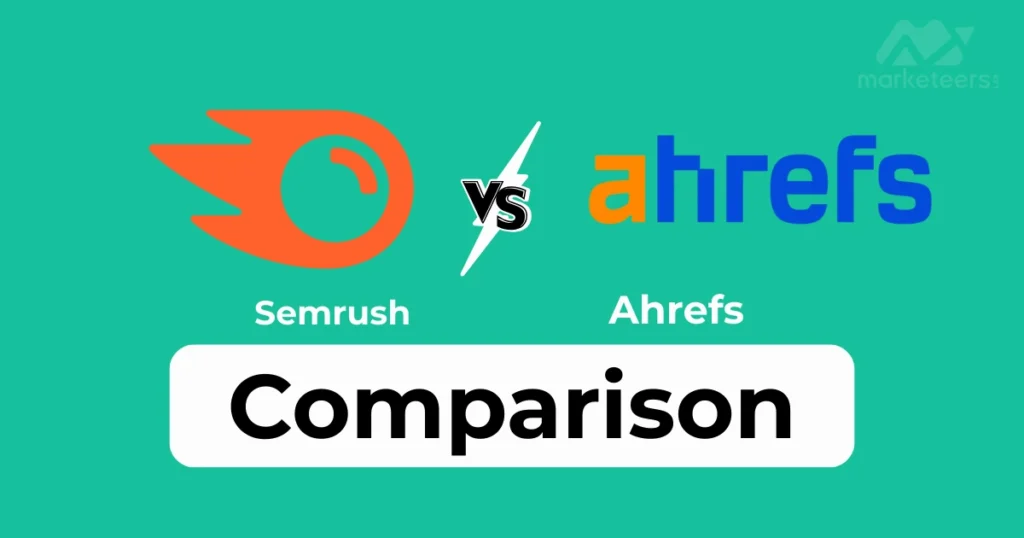If you want to boost your website’s traffic and crush your competition, choosing the right SEO tool is key. You’ve probably heard of Semrush and Ahrefs, two of the most popular options out there.
But which one truly fits your needs? This comparison will cut through the noise and help you make a clear choice. By the end, you’ll know exactly which tool can give your SEO strategy the edge it needs. Keep reading to find out which one is right for you.
Key Features Compared
Comparing Semrush and Ahrefs means looking closely at their key features. These tools help with SEO but offer different strengths. Understanding their features helps choose the right tool for your needs.
Keyword Research Tools
Semrush provides detailed keyword suggestions and search volume data. It shows keyword difficulty and trends over time. Ahrefs offers a large database of keywords with click metrics. It helps find related keywords and questions users ask. Both tools help find valuable keywords for your content.
Backlink Analysis
Ahrefs is strong in backlink analysis with a huge link index. It shows new and lost backlinks clearly. Semrush also tracks backlinks but with fewer details. Both tools help spot backlink opportunities and risks. Ahrefs offers more depth for link quality and anchor text.
Site Audit Capabilities
Semrush runs thorough site audits identifying SEO issues and errors. It offers clear reports on site health and fixes needed. Ahrefs also audits sites but focuses more on crawl errors and broken links. Both tools help keep your website SEO-friendly and error-free.
Content Marketing Features
Semrush offers tools for content ideas, SEO writing, and topic research. It helps create content that ranks well. Ahrefs helps analyze competitor content and find gaps. Both provide insights to improve your content strategy and engage readers.
User Interface And Experience
Semrush has a clean, modern interface with easy navigation. It suits beginners and experts alike. Ahrefs offers a simple, straightforward dashboard with quick access to tools. Both are user-friendly but differ in layout and design. Choose what feels easier to use.
Pricing And Plans
Choosing the right SEO tool depends a lot on price and what each plan offers. Both Semrush and Ahrefs have several pricing options. Each plan fits different needs and budgets. Understanding their pricing helps you pick the best tool for your goals.
Subscription Tiers
Semrush offers four main plans: Pro, Guru, Business, and Enterprise. Pro is for beginners and small teams. Guru suits growing businesses with extra features. Business targets large companies with advanced tools. Enterprise is custom-priced for very large needs.
Ahrefs has four plans: Lite, Standard, Advanced, and Agency. Lite fits small projects and beginners. Standard is popular for most users. Advanced and Agency serve bigger teams and agencies. Each tier adds more reports and limits.
Value For Money
Semrush includes many tools like SEO, content, and social media. It gives a broad range of features in one package. This can save money by using one tool for many tasks.
Ahrefs focuses on SEO and backlink analysis with strong data. It offers deep insights but fewer extras outside SEO. It suits users who need solid SEO data only.
Both tools give good value. Semrush is better for all-in-one marketing. Ahrefs is ideal for pure SEO research.
Free Trials And Limitations
Semrush offers a 7-day free trial with limited access to features. Some tools and data limits apply during the trial. You must enter payment details to start.
Ahrefs does not have a free trial but offers a 7-day trial for $7. The trial includes most features but has usage limits. No free plan is available.
Both tools restrict data and reports in trials. These limits help test the platform without full access.
Performance And Accuracy
Performance and accuracy are key factors in choosing between Semrush and Ahrefs. Both tools offer data that helps improve SEO strategies. The quality of this data affects the decisions users make. Accurate and up-to-date information leads to better results. This section compares how Semrush and Ahrefs perform in these areas.
Data Freshness
Data freshness means how often the tool updates its information. Semrush updates keyword and backlink data regularly. This keeps the insights current and reliable. Ahrefs also refreshes its data frequently, especially for backlinks. Timely updates help users track changes quickly. Both tools score well in keeping data fresh.
Search Engine Coverage
Search engine coverage shows which search engines the tools track. Semrush covers major engines like Google, Bing, and Yahoo. It offers data for different countries and languages. Ahrefs focuses mostly on Google data but provides detailed analytics. This is important for global SEO campaigns. Semrush has a slight edge in broader coverage.
Report Customization
Report customization allows users to tailor reports to their needs. Semrush offers flexible options to choose metrics and data views. Users can create reports for different projects easily. Ahrefs provides clean and simple report formats. It is good for quick analysis but less customizable. Semrush offers more control over report details.
Integrations And Api Access
Integrations and API access are key for SEO tools. They allow users to connect different software and automate tasks. Both Semrush and Ahrefs offer options to extend their functionality. Understanding their integrations and API features helps choose the right tool for your needs.
Third-party Integrations
Semrush supports many third-party tools. It connects with Google Analytics, Google Search Console, and social media platforms. These integrations help users track SEO and marketing data in one place. Ahrefs has fewer direct integrations. It mainly focuses on its own dashboard and data. This can limit linking to other apps.
Api Features
Semrush provides a comprehensive API. It allows users to pull keyword, backlink, and site audit data. The API supports automation and custom reports. Ahrefs also offers an API but with less data access. It mainly covers backlink and organic search data. Semrush’s API is better for in-depth data needs.
Workflow Compatibility
Semrush fits well with various workflows. Its integrations and API help combine SEO with marketing tools. Teams can automate reporting and data updates easily. Ahrefs works best as a standalone tool. It suits users who want straightforward SEO data without many extras. Choose Semrush for broader workflow use.
Customer Support And Resources
Customer support and resources are key when choosing SEO tools like Semrush and Ahrefs. Both platforms offer help to users, but the ways they assist differ. Good support saves time and reduces frustration. Useful resources help users learn and use the tools better.
Support Channels
Semrush offers live chat, email, and phone support. Users get quick answers during business hours. Ahrefs provides email support and a contact form. They respond within a day or two. Neither platform offers 24/7 phone support. Semrush has a slight edge with more direct contact options.
Learning Materials
Semrush has an extensive knowledge base with guides and tutorials. Their blog covers SEO trends and tips. Ahrefs offers a detailed blog and video tutorials. They focus on teaching SEO basics and strategies. Both platforms update content regularly to stay relevant. Semrush’s materials are easier for beginners to follow.
Community And Forums
Semrush hosts an active online community and webinars. Users share tips and ask questions. Ahrefs relies more on its blog and YouTube channel. It lacks a dedicated user forum. Semrush’s community helps users connect and solve problems faster. This makes learning from others easier.
Best Use Cases
Choosing the right SEO tool depends on your needs and goals. Semrush and Ahrefs offer strong features but suit different users best. Understanding their best use cases helps you pick the right one. Each tool shines in certain areas and for specific users.
Freelancers And Small Businesses
Freelancers and small businesses need affordable tools with easy learning curves. Semrush offers a wide range of features like keyword research, site audits, and competitor analysis. It works well for those who want an all-in-one SEO platform.
Ahrefs provides detailed backlink data and strong keyword tools. It suits users focused on link building and content strategies. Both tools help improve online visibility but serve different priorities.
Agencies And Enterprises
Agencies and large companies require advanced tools with scalable options. Semrush supports multiple projects and team collaboration. It includes marketing insights beyond SEO, such as social media and PPC data.
Ahrefs excels in deep backlink analysis and large-scale keyword tracking. Its data accuracy appeals to teams focusing on link profiles and SEO audits. Both platforms offer APIs for custom integrations.
Content Creators And Marketers
Content creators need tools that guide topic ideas and SEO optimization. Semrush provides content templates and writing assistance. It helps optimize articles for better search rankings.
Ahrefs focuses on content gap analysis and competitor research. It reveals what topics perform well in your niche. Both tools support content marketing but emphasize different strategies.
Pros And Cons
Choosing between Semrush and Ahrefs can be tough. Both offer powerful SEO tools but have different strengths and weaknesses. Understanding these can help you pick the best fit for your needs.
Semrush Strengths And Weaknesses
Semrush offers a wide range of tools for SEO, PPC, and content marketing. Its user interface is simple and clean. The keyword research tool is very detailed, helping find many keyword ideas. Site audit features are strong, showing clear issues and fixes. It also has a large database of backlinks.
On the downside, Semrush can be expensive for small users. Some reports take time to load. The learning curve can be steep for beginners. Its backlink data is not as deep as Ahrefs in some cases. The pricing plans may feel complex due to many options.
Ahrefs Strengths And Weaknesses
Ahrefs excels in backlink analysis with one of the largest databases. Its site explorer tool is fast and accurate. The keyword explorer provides solid keyword difficulty scores. Ahrefs has an easy-to-use interface. It offers strong content analysis features to track top-performing pages.
Its limitations include fewer features outside SEO. Ahrefs does not have PPC tools like Semrush. The site audit tool is less detailed. Pricing can be high for small businesses. Some users find the reporting features less flexible.
Frequently Asked Questions
Which Tool Is Better For Keyword Research, Semrush Or Ahrefs?
Both Semrush and Ahrefs excel in keyword research. Semrush offers more detailed keyword suggestions and competitive analysis. Ahrefs provides accurate search volume and keyword difficulty metrics. Your choice depends on specific needs like keyword ideas or backlink insights.
How Do Semrush And Ahrefs Compare For Backlink Analysis?
Ahrefs is widely known for its extensive backlink database and detailed link reports. Semrush also offers strong backlink analysis but with more integrated SEO tools. For pure backlink research, Ahrefs is often preferred, while Semrush suits broader SEO strategies.
Can Semrush Or Ahrefs Improve My Site’s Seo Performance?
Yes, both tools help improve SEO by offering insights on keywords, backlinks, and site audits. Semrush provides comprehensive marketing tools, while Ahrefs focuses on backlinks and content analysis. Using either can boost your website’s search rankings effectively.
Which Platform Offers Better Competitor Analysis Features?
Semrush provides more in-depth competitor insights, including traffic analytics and advertising data. Ahrefs focuses on competitor backlink profiles and organic keywords. For a holistic competitor overview, Semrush is generally more comprehensive.
Conclusion
Both Semrush and Ahrefs offer strong SEO tools for different needs. Semrush excels in keyword research and site audits. Ahrefs shines with backlink analysis and content ideas. Choose based on your specific goals and budget. Testing each tool can help find the best fit.
Quality SEO work depends on how you use these tools. Keep learning and adapting your strategies. Success takes time and effort, not just software.



